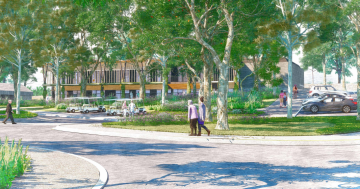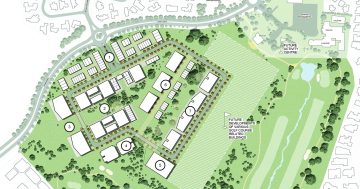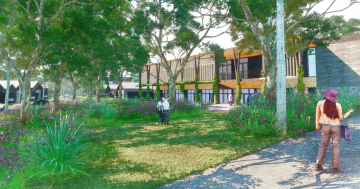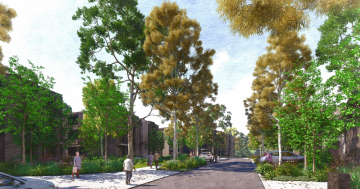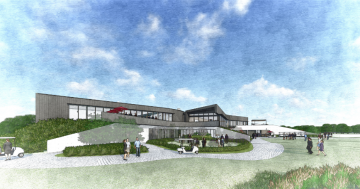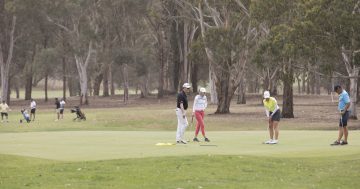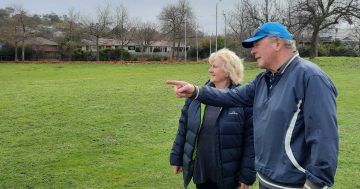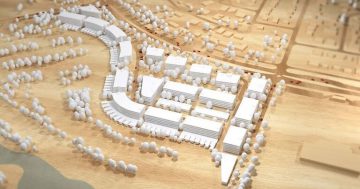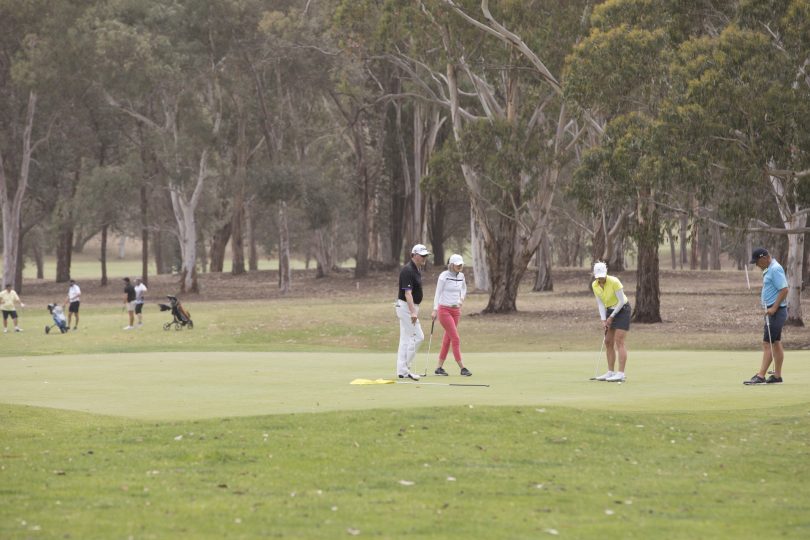
On the green at the Federal Golf Club course in Red Hill. The club is weighing up two development options. Photo: File.
The increasing cost of maintaining golf course facilities in the ACT, including water charges, is driving a welter of development proposals as clubs try to cash in on soaring land values, but they face community opposition and new planning rules that limit their options.
The proposals, which require rezoning of the land, usually meet opposition from nearby residents alarmed at the loss of green space, amenity and views, and clubs attempting to capitalise on converting concessional leases granted to provide community facilities.
In recent years, most clubs across the ACT have been looking to slice off portions of land that they believe are surplus to requirements for a mix of commercial and residential development, and some are now fielding unsolicited bids from developers offering reliable income streams.
The retirement industry views golf clubs as compatible investment partners, and the government is amenable to new aged care facilities being provided in the Territory.
Federal Golf Club in the inner south, which has been trying to develop part of the course for 15 years, linked with Sydney-based Over 55s developer Mbark to build a retirement village some years ago, and has now received an alternative offer from a Canberra consortium.
In December, developer Nikias Diamond, Stewart Architecture and Canberra Southern Cross Club proposed a $25 million development consisting of a 36-room hotel, 300-person function centre, health club, new clubhouse and associated works.

The concept plan for Federal Golf Club from the Canberra consortium. Image: FGC.
It would be smaller than the 20,000 square metre Mbark proposal, taking up only 6,000 square metres, but with a bigger clubhouse.
The proposal indicates that the development would be funded entirely by the developers and that the Golf Club would receive around $1 million a year as ‘landlord’.
Any development is dependent on the outcome of the draft Integrated Plan for Red Hill Nature Reserve and Surrounds, which gave the thumbs up to the Mbark proposal in the southern end of the course, but COVID-19 and the election have delayed the release of the consultation report and the draft plan’s referral to the Legislative Assembly.
The draft plan itself arose out of community concern that culminated in an Assembly resolution.
Golf club director and chair of the development committee Bob Correll says the club remains open to all proposals, but the new one did not appear to fit with the draft plan, which the club supports.
He said the club and Mbark would be able to quickly submit a development application in consultation with the community once the Assembly finalised the draft plan.
Mr Correll said the club’s financial needs were quite serious, with increasing dam capacity and upgrading ageing infrastructure, including irrigation equipment, a priority.
The pressure on the club last summer was severe, and it needed to find revenue to maintain the course and keep operating.
”Sooner or later we’ll strike another drought,” he said, adding that membership had increased and the game itself was booming, but the clubhouse too needed upgrading.
Murrumbidgee Country Club in Kambah has identified three sites for possible development and wanted to build a mix of houses, townhouses and units.
Those plans appear to have been shelved due to a government tightening of planning rules, but in December the Knowles Group approached the club with a retirement village concept that would include units, an aged care centre, new clubhouse and amenities such as a swimming pool, bowling green and theatre.
Like the latest Federal proposal, it would guarantee a yet-to-be-determined annual income.
The club says that it and Knowles will work on a development proposal to be presented the ACT Government this year.

Murrumbidgee Country Club in Kambah is hopeful a retirement village proposal will secure its future. Photo: MCC.
Director of finance Lynne O’Brien said she was hopeful the new proposal would meet government requirements and that its promise of more facilities would generate support from the community.
”One of the criticisms we’ve had thrown at us over the years is that we’re supposed to be a country club. People were promised that 30 years ago and they don’t have a bowling green or swimming pool, or any country club-like facilities,” she said.
But it would also change the club’s borderline year-to-year existence, hovering between small surpluses and deficits, to a more secure future.
In 2019-20, the club, which employs about 15-20 staff, spent $60,000 buying potable water for the greens and critical parts of the course, spending $14,000 a week during the peak drought period.
”The need to purchase water is always a big risk,” she said.
Ms O’Brien said the club’s previous residential development plans struck opposition from a small hardcore group, but the vast majority of residents understood the club’s motivation.
Plans at other golf clubs appear to be on ice, with little progress since 2018.
Yowani Country Club – which occupies a prime site at the intersection of Northbourne Avenue, the Barton Highway and the Federal Highway – teamed up with Canberra developer TP Dynamics to turn a new master plan into reality and exploit the opportunities offered by urban renewal along the Northbourne corridor.
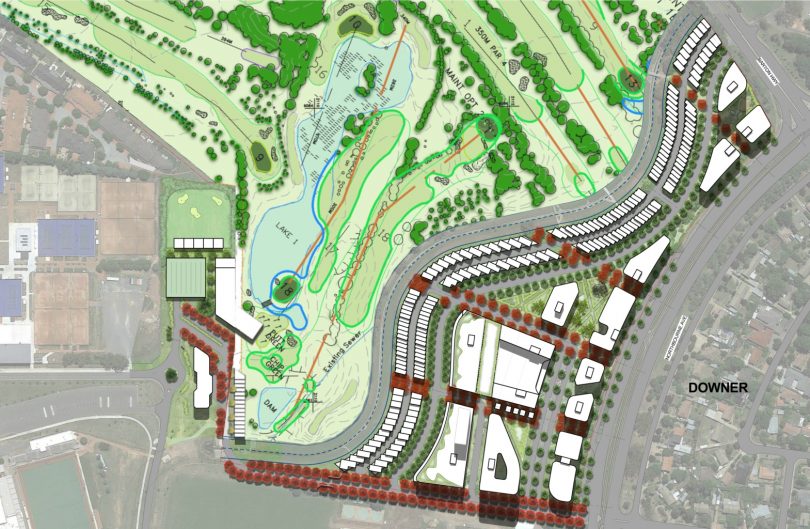
Yowani Country Club’s master plan showing increasing density towards Northbourne Avenue. Image: Yowani.
The mixed-use development plans included terraces and townhouses, with increasing density towards Northbourne Avenue and a commercial zone of retail, offices and cafes.
There would also be a new clubhouse on the opposite side of Sullivan’s Creek looking out over a new 18th green.
In 2018, Konstantinou Group’s Gold Creek Country Club went to the Gungahlin community with a plan to shrink the course and seek ideas on how to develop about 49 hectares of land, four years after its previous redevelopment bid.
But the plans were put on hold after a community backlash from nearby Nicholls residents.
Director Harry Konstantinou says the club will still need to pursue a development option if it is to survive.
”With 500 members, and 900,000 square metres of land, it is just not a sustainable use of land and in the end somebody needs to subsidise these 500 golfers playing golf,” he said.
”While at the moment this is the Konstantinou Family, this is not an endless exercise and one day we may not be in a position to continue to subsidise.”
The number of requests from golf clubs to rezone recreational land prompted a review of the PRZ2 Restricted Access Recreation Zone and the CZ6 Leisure and Accommodation Zone of the Territory Plan due to concerns about the impact on the limited amount of such land in the ACT.
The outcome has made it harder for golf clubs to redevelop courses, especially for residential purposes.
The Environment, Planning and Sustainable Development Directorate’s criteria indicate that development must be linked to a golf club’s primary use, and be owned and managed by it and not sold off separately, so any income goes back into the facilities.
A club must also retain 18 holes, and show that the surplus land is not needed for future sporting use in the long term.
An ACT Government spokesperson said the independent planning and land authority would assess any golf club development application.
”The rezoning of any part of a golf course site can be considered, provided the golf course remains and the proposed development is a use that is integrated with the club,” the spokesperson said.
”Any proposal will be considered on its merits and in the context of the recreational and sporting needs of our community.
”The views of the community will be considered with any assessments, alongside broader planning considerations.”
The spokesperson added that the government was assisting clubs with the cost of water.
Those clubs impacted by the summer bushfires and associated smoke as well as the COVID-19 pandemic can apply for rebates on non-potable water costs (including treated effluent), and water abstraction charges incurred from 1 October are capped for 12 months at the usage level for the same period 12 months earlier.
”We will continue the 50 per cent discount for the Water Abstraction Charge (WAC) by extending the offset for investments against the charge for a further 12 months and allowing the offset to be claimed against more recent investments to help clubs continue to adapt,” the spokesperson said.
”These measures will assist with water costs commencing from the summer period.”
The government will also examine charging options for high-intensity users of non-potable water, such as golf clubs and community-managed sports ovals.
”There is a case to be made for public subsidy of these activities on the grounds of encouraging physical activity, social interaction and community building,” the spokesperson said.











